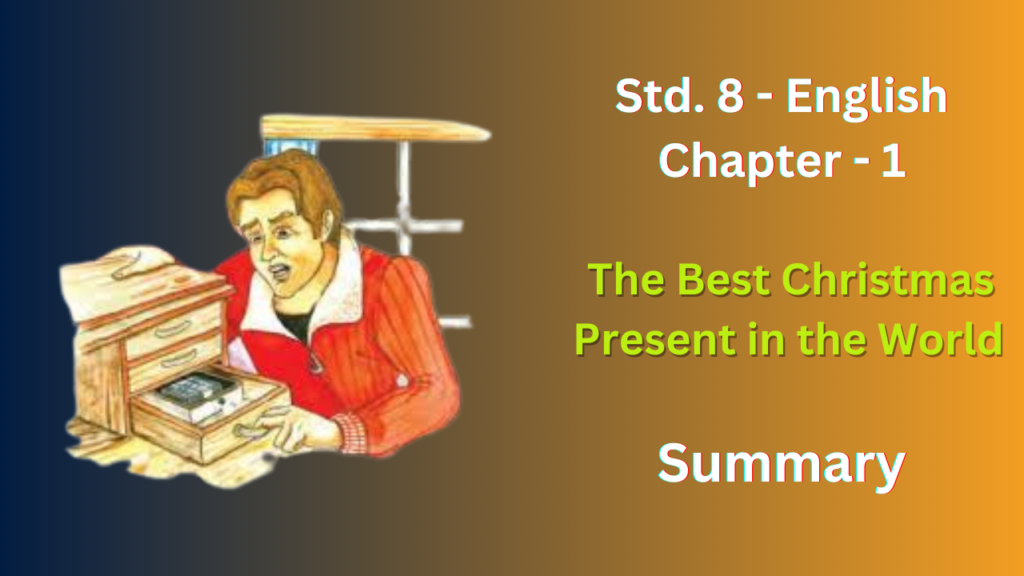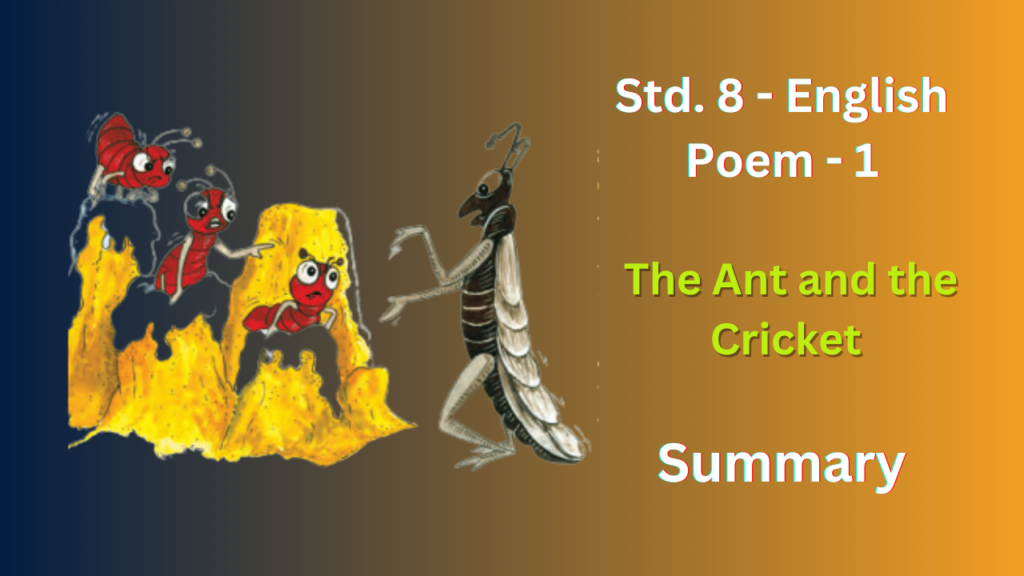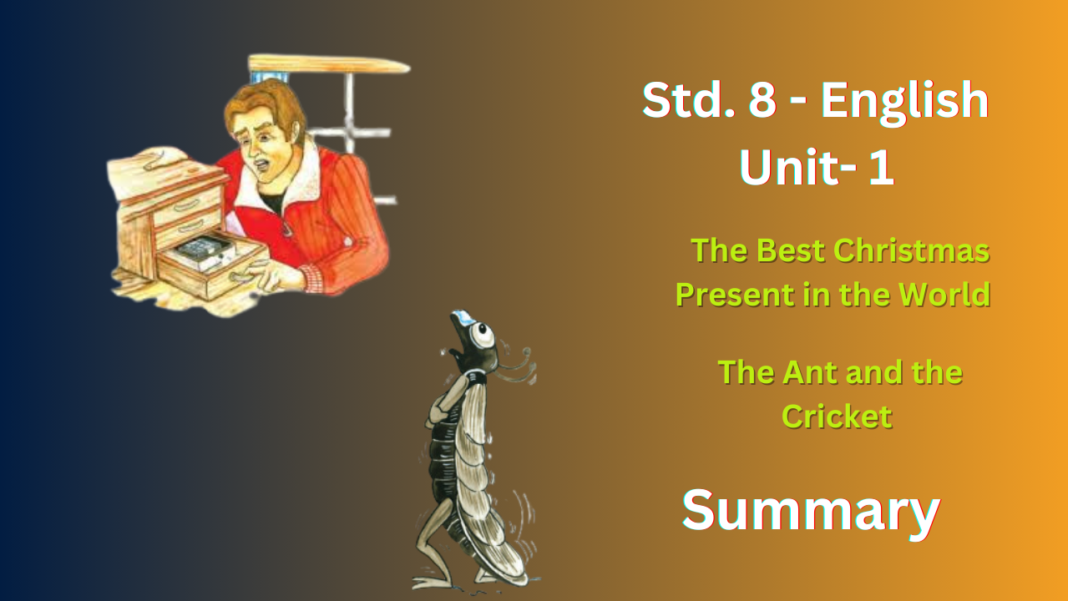NCERT Solutions for Class 8 English Chapter 1
The Best Christmas Present in the World
The story, “The Best Christmas Present in the World,” follows a man who stumbles upon a heartwarming discovery on Christmas Eve. He buys a beat-up roll-top desk from a junk shop, intending to restore it. As he works on Christmas Eve night, he uncovers a hidden compartment in the bottom drawer. Inside, he finds a small tin box containing a faded letter.
The letter, dated December 1914, is addressed to Mrs. Connie Macpherson and signed by Jim Macpherson. Intrigued, the man reads the letter, which reveals an incredible story. Jim, a soldier fighting in World War I, describes an unforgettable Christmas Day experience.
In the midst of the brutal war, a sense of humanity emerges. Enemy soldiers, Germans and British on the battlefield, decide to lay down their arms for a day. A spontaneous truce takes hold, and the soldiers from opposing sides cautiously approach each other. What follows is a remarkable display of camaraderie. They share cigarettes, sing carols together, even play a friendly football game.
The letter overflows with Jim’s joy at experiencing a brief respite from the horrors of war. He describes the shared laughter, the sense of brotherhood, and the overwhelming wish for peace. The letter ends with Jim expressing his longing to be back home with Connie.
Deeply moved by the letter, the man feels compelled to find Connie. With some effort, he locates her living in a nursing home. He hesitates, unsure of what to expect, but ultimately decides to meet her. Connie, frail and with failing memory, mistakes him for her husband Jim returning home from the war.
Despite the man’s attempts to explain the situation, Connie remains convinced. The joy and relief on her face are undeniable. Seeing the happiness he brings Connie, even under false pretenses, allows the man to understand the title’s meaning. The letter, a testament to the power of human connection and the yearning for peace, becomes the “Best Christmas Present in the World” for Connie.
NCERT Solutions for Class 8 English Chapter 1 : The Best Christmas Present in the World

Comprehension Check
1. What did the author find in a junk shop?
Ans : In the story “The Best Christmas Present in the World,” the author doesn’t explicitly tell us who the narrator is. However, the narrator finds a very interesting item in a junk shop on Christmas Eve: a beat-up, old roll-top desk. This seemingly ordinary purchase turns out to be much more, as the desk holds a hidden secret waiting to be discovered.
2. What did he find in a secret drawer? Who do you think had put it in there?
Ans : The letter itself offers clues about who might have hidden it. It’s written by a soldier named Jim and addressed to his wife, Connie. This suggests the previous owner was likely Connie herself. She might have kept the letter as a cherished reminder of Jim, perhaps during or after the war, and hidden it away for safekeeping in the secret drawer of the desk.
Comprehension Check
1. Who had written the letter, to whom, and when?
Ans : The letter found in the secret drawer was written by a soldier named Jim Macpherson. He addressed it to his wife, Connie Macpherson. The date on the letter places it in December 1914, during the first World War.
2. Why was the letter written — what was the wonderful thing that had happened?
Ans : The letter written by Jim in “The Best Christmas Present in the World” wasn’t written to describe a typical wartime experience. Jim wrote to tell his wife, Connie, about a truly wonderful thing that happened on Christmas Day.
3. What jobs did Hans Wolf and Jim Macpherson have when they were not soldiers?
Ans : The letter mentions Jim was a school teacher from Dorset, England, before joining the army.
4. Had Hans Wolf ever been to Dorset? Why did he say he knew it?
Ans : Dorset was a place Hans only knew from books. Thomas Hardy’s novel “Far from the Madding Crowd” had painted a picture of the county in his mind, but he’d never actually set foot there.
5. Do you think Jim Macpherson came back from the war? How do you know this?
Ans : Jim Macpherson did not come back from the war.
Comprehension Check
1. Why did the author go to Bridport?
Ans : To deliver the letter: He felt a responsibility to return the letter to its rightful owner, Connie, after discovering its sentimental value and the story it held.
2. How old was Mrs Macpherson now? Where was she?
Ans : Mrs. Macpherson was most likely 101 years old. The story doesn’t explicitly state her age, but when the man finds her, she’s in a nursing home.
Comprehension Check
1. Who did Connie Macpherson think her visitor was?
Ans : Connie mistook the visitor for her husband, Jim Macpherson.
2. Which sentence in the text shows that the visitor did not try to hide his identity?
Ans : With a warm smile, Connie addressed the visitor, “You told me you’d return by Christmas, my love, and here you are, the greatest Christmas gift imaginable. Come closer, Jim dear, sit down.”
Working With Text
1. For how long do you think Connie had kept Jim’s letter? Give reasons for your answer.
Ans : Jim’s final letter, written on December 26, 1914, remained in Connie’s possession until January 25, 1915.
2. Why do you think the desk had been sold, and when?
Ans : The desk was likely sold after a fire damaged Connie’s home, necessitating a move to a nursing home. The sale would have occurred sometime between the fire and her move.
3. Why do Jim and Hans think that games or sports are good ways of resolving conflicts? Do you agree?
Ans : Soldiers Jim and Hans, hardened by war’s brutality, yearned for peace. They believed games and sports, with their emphasis on fair competition, offered a more humane way to settle disputes. I wholeheartedly agree.
4. Do you think the soldiers of the two armies are like each other, or different from each other? Find evidence from the story to support your answer.
Ans : People are all alike in some ways. They don’t like war and want peace. They want to be friends, even in war. Remember the soldiers who yelled “Merry Christmas” across the battlefield? That shows even enemies can want to get along.
5. Mention the various ways in which the British and the German soldiers become friends and find things in common at Christmas.
Ans : The story suggests British and German soldiers connected at Christmas by calling greetings across no man’s land, possibly sharing food, and maybe even playing games.
6. What is Connie’s Christmas present? Why is it the best Christmas present in the world?
Ans : Connie’s Christmas present isn’t a physical object, but rather a comforting delusion. She mistakes the visitor for her husband, Jim Macpherson, who she’d been waiting for and had written to her saying he’d be home for Christmas. This belief that Jim has returned home is the “best Christmas present in the world” for Connie because it brings her immense joy and a sense of reunion.
7. Do you think the title of the story is suitable for it? Can you think of any other title(s)?
Ans : The title “The Best Christmas Present in the World” is absolutely suitable for the story. It perfectly captures the central theme: Connie’s mistaken belief that the visitor is her husband, Jim, is the greatest gift she could receive.
Here are some alternative titles :
Christmas Wish
A Christmas Delusion
Peace on Christmas
Working With Language
1. Look at these sentences from the story.
I spotted it in a junk shop in Bridport… The man said it was made in the early nineteenth century… This one was in a bad condition…
The italicised verbs are in the past tense. They tell us what happened in the past, before now.
(i) Read the passage below and underline the verb in the past tense.
A man got on the train and sat down. The compartment was empty except for one lady. She took her gloves off. A few hours later the police arrested the man. They held him for 24 hours and then freed him.
Ans : The verbs in the past tense in the passage are:
- got (on)
- sat down
- was
- took (off)
- arrested
- held
- Freed
(ii) Fill in the blanks using the correct form of the verbs in brackets.
My little sister is very naughty. When she———- (come) back from school yesterday, she had ———- (tear) her dress. We——————————————————— (ask) her how it had——– (happen). She—– (say) she——- (have, quarrel) with a boy. She———– (have, beat) him in a race and he——— (have, try) to push her. She——— (have, tell) the teacher and so he——- (have, chase) her and she———- (have, fall) down and——– (have, tear) her dress.
Ans :
My little sister is very naughty. When she came back from school yesterday, she had torn her dress. We asked her how it had happened. She said she had quarreled with a boy. She had beaten him in a race and he had tried to push her. She had told the teacher and so he had chased her and she had fallen down and had torn her dress.
(iii)Underline the verbs and arrange them in two columns, Past and Earlier
(a) My friends set out to see the caves in the next town, but I stayed at home, because I had seen them already.
(b) When they arrived at the station, their train had left. They came back home, but by that time I had gone out to see a movie!
(c) So they sat outside and ate the lunch I had packed for them.
(d) By the time I returned, they had fallen asleep!
Ans :
| Past | Earlier Past |
| set out | had seen |
| arrived | had left |
| came back | had gone out |
| ate | had packed |
| returned | had fallen asleep |
2. Dictionary Work
By the end of the journey, we had run out of drinking water.
Look at the verb run out of in this sentence. It is a phrasal verb: it has two parts, a verb and a preposition or an adverb. Phrasal verbs often have meanings that are different from the meanings of their parts.
Find these phrasal verbs in the story.
1. Burn out
2. Light Up
3.Look on
4. Run out
5. Keep out
Write down the sentences in which they occur. Consult a dictionary and write down the meaning that you think matches the meaning of the phrasal verb in the sentence.
Ans :
- “House number 12 turned out to be nothing but a burned-out shell …………….. (destroyed by fire).
- That was the moment her eyes lit up with recognition, and her face……………… (brightened).
- Hans Wolf and I looked on and cheered, clapping our hand……… : (considered somebody to be somebody)
- The time came, and all too soon when the game was finished, the schnapps and the run and the sausage had long since run out, and we knew it was all over, (become used up, finished)
- Hans Wolf and I looked on and cheered clapping our hands and stamping our feet, to keep out the cold as much as anything, (to avoid)
3. The table below contains a list of nouns and some adjectives. Use as many adjectives as you can to describe each noun. You might come up with some funny descriptions!
| Nouns | Adjectives |
| elephant | circular, striped, enormours,multicoloured, round, cheerful,wild, blue, red, chubby,large, medium-sized, cold |
| face | |
| building | |
| water |
Ans :
- elephant—enormous, striped, wild
- face—cheerful, round, chubby
- building—circular, large, multicoloured
- water—blue, cold.
NCERT Solutions for Class 8 English Chapter 1 : Poem
The Ant and the Cricket
The Ant and the Cricket is a fable in the form of a poem that teaches a lesson about the importance of hard work and preparedness. Here’s a summary:
Characters:
- The Industrious Ant: Hardworking, spends the summer collecting food and building shelter for the winter.
- The Carefree Cricket: Lazy and spends the summer singing and enjoying himself without preparing for winter.
Plot:
- During the summer, the ant works tirelessly while the cricket mocks him for not enjoying life.
- Winter arrives, and the cricket finds himself starving and without shelter due to his lack of preparation.
- He begs the ant for food and shelter, but the ant refuses, reminding him of his carefree attitude during the summer.
Lesson:
The poem emphasizes the importance of planning for the future. Through the ant’s success and the cricket’s misfortune, it highlights the consequences of laziness and
Working With Poem
The Ant and the Cricket is a fable in the form of a poem that teaches a lesson about the importance of hard work and preparedness. Here’s a summary:
Characters:
- The Industrious Ant: Hardworking, spends the summer collecting food and building shelter for the winter.
- The Carefree Cricket: Lazy and spends the summer singing and enjoying himself without preparing for winter.
Plot:
- During the summer, the ant works tirelessly while the cricket mocks him for not enjoying life.
- Winter arrives, and the cricket finds himself starving and without shelter due to his lack of preparation.
- He begs the ant for food and shelter, but the ant refuses, reminding him of his carefree attitude during the summer.
Lesson:
The poem emphasizes the importance of planning for the future. Through the ant’s success and the cricket’s misfortune, it highlights the consequences of laziness and the value of hard work and foresight.
NCERT Solutions for Class 8 English Chapter 1 : The Ant and the Cricket

Working With Poem
1.The cricket says, “Oh! What will become of me?” When does he say it, and why?
Ans : The cricket cries out in winter when he realizes he has no food or shelter, facing the consequences of his summer laziness.
2. (i) Find in the poem the lines that mean the same as “Neither a borrower nor a lender be” (Shakespeare).
Ans : These lines express the ant’s philosophy of self-reliance and avoiding dependence on others, similar to Shakespeare’s idea of not relying on borrowing or lending money.
(ii) What is your opinion of the ant’s principles?
Ans : The ant’s principles are a double-edged sword. While his planning and self-reliance are admirable, his refusal to help seems harsh. There’s a balance between responsibility and compassion.
3. The ant tells the cricket to “dance the winter away.” Do you think the word ‘dance’ is appropriate here? If so, why?
Ans : “Dance” isn’t literal. It’s sarcastic, mocking the cricket’s summer laziness and implying his lack of preparation won’t help him survive winter.
4. (i) Which lines in the poem express the poet’s comment? Read them aloud.
Ans : “Folks call this a fable, I’ll warrant it true.”
These lines spoken by the narrator are a direct comment from the poet. You can read them aloud with a slightly reflective tone, perhaps even a touch of amusement.
(ii) Write the comment in your own words.
Ans : “People might call this a made-up story, but I bet it reflects real life!”
5. If you know a fable in your own language narrate it to your classmate
Ans : The Lion and the Mouse
Once upon a time, a mighty lion was taking a nap in the jungle. A tiny mouse scurried across the lion’s nose, waking him from his slumber. The lion roared in anger and was about to swat the little mouse when the mouse squeaked, “Please, mighty lion, forgive me! I didn’t mean to disturb your rest.”
The lion, surprised by the tiny creature’s bravery, chuckled and let the mouse go. “A small creature like you couldn’t possibly harm me,” he said. The mouse thanked the lion and scurried away.
Later, while the lion was hunting, he got caught in a poacher’s net. He roared and struggled, but he couldn’t break free. Just then, the little mouse scurried by and saw the lion’s predicament. Remembering the lion’s mercy, the mouse quickly gnawed at the ropes of the net. With a snap, the net broke, and the lion was free.
The mighty lion, humbled, thanked the tiny mouse. “You see,” squeaked the mouse, “even the smallest creature can be helpful.”
Moral of the story: Kindness and compassion are valuable traits. No matter how big or small you are, you can always help someone in need.
NCERT Solutions for Class 8 English Chapter 1
FAQ’s
What is the summary of “The Best Christmas Present in the World”?
“The Best Christmas Present in the World” is about a letter written by a soldier named Jim during World War I to his wife, Connie. The letter describes a unique Christmas truce between British and German soldiers. Decades later, the letter is discovered in an old desk and brought back to Connie, giving her immense joy and closure.
What is the theme of “The Ant and the Cricket” in Class 8 English Chapter 1?
The theme of “The Ant and the Cricket” in Class 8 English Chapter 1 revolves around the importance of hard work and planning for the future. It contrasts the industrious ant with the carefree cricket to convey the message that preparation and effort are crucial for survival.
What are the key points in “The Ant and the Cricket”?
Key points in “The Ant and the Cricket” include the contrasting characters of the diligent ant and the lazy cricket, the moral of planning for the future, and the consequences of neglecting one’s duties. The story emphasizes the value of hard work and foresight.
What lesson do we learn from “The Best Christmas Present in the World”?
“The Best Christmas Present in the World” teaches us about the power of hope, the enduring human spirit, and the unexpected connections that can bring joy and solace. It highlights the significance of peace, love, and the simple yet profound acts of kindness during times of conflict.
Who are the main characters in “The Ant and the Cricket”?
The main characters in “The Ant and the Cricket” are the hardworking ant, who represents foresight and diligence, and the carefree cricket, who represents negligence and short-sightedness.
How does “The Best Christmas Present in the World” relate to historical events?
“The Best Christmas Present in the World” relates to the historical event of the Christmas truce during World War I in 1914, where soldiers from opposing sides came together to celebrate Christmas, demonstrating humanity and peace amidst war.
What is the moral of “The Ant and the Cricket”?
The moral of “The Ant and the Cricket” is that one should always be prepared and work hard to secure their future. It teaches the importance of being industrious and responsible.









